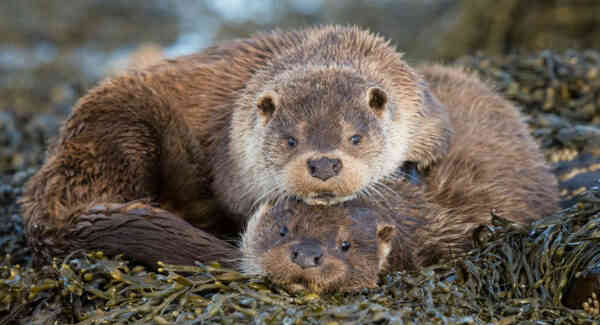Being partly aquatic, otters are intelligent and cunning animals. They skillfully disguise their dwellings to protect them from being plundered by other animals or humans, and they do it so skillfully that it is almost impossible to detect them. However, their high intelligence is confirmed by a number of experiments. The only pity is that these animals have to regularly leave their usual habitats when they are forced out by human civilization.
Interesting facts about otters
- There are only 3 species of these animals in the world. For comparison, there are about 9,000 species of ants on Earth.
- Otter fur is so dense that there are up to 125,000 thousand hairs per square centimeter of skin. This helps her stay warm and not get wet.
- From a biological point of view, martens and badgers are relatives of the otter (interesting facts about badgers).
- These animals can hold their breath for one and a half to two minutes, remaining under water for a long time.
- Despite the fact that the otter’s burrow is dug in the ground, the only entrance to it is always located below the surface of the water, and you can get inside only from the river.
- The basis of the otter’s diet is fish. She usually eats a trifle immediately after the capture, and in order to thoroughly eat a big fish, the animal pulls the prey ashore.
- An otter can sleep right in the water. To prevent it from being carried away by the current, it first climbs into thickets of algae and wraps itself around them. Thus, the algae serve as its anchor.
- An amazing giant otter lives in Brazil, similar to its relatives from Europe very remotely. Its impressive size allows it to hunt even young crocodiles.
- The weight of an adult otter does not exceed 10 kg, and usually fluctuates around the mark of 7-8 kg.
- In summer, they usually have no shortage of food, but in winter everything is much more difficult. In search of food, otters often travel up to 20 kilometers a day.
- These smart animals often fish with the whole flock, driving the fish school into shallow water, where prey is easy to catch.
- In winter, otters sometimes roll down snow-covered hills – they lie on their stomachs, push off, lift their paws and roll down right on their furry belly, like children on a sled. It looks really funny.
- In Bangladesh, local fishermen tame otters and use them as assistants – they help them drive fish into nets.
- During hunting, otters often get excited, and they catch more fish than they eat.
- In 2000, common otters were recognized as a vulnerable species. Relatively freely, they still live only in the Far East, in those places where there are almost no people.
- Otters were hunted by ancient people who highly valued her fur. It is incredibly strong and durable, and things made from it last 15-20 times longer than things made from, for example, rabbit fur (interesting facts about ancient people).
- The structure of the eyes of the otter is unique. Nature calculated everything so that these amazing creatures could see equally well both in the air and under water.
- The only continents where there are no otters are Antarctica and Australia.
- Despite their relatively short legs, common otters on land can run at a speed of 25-30 km/h. And they swim very fast.
- Sometimes, instead of digging holes, they occupy natural caves or simply equip their nest in dense coastal thickets.
- Some otters settle in ponds and lakes, but in the vast majority of cases they prefer running water, and therefore live in rivers.
- Due to their special structure, the nostrils and auricles of these animals automatically close when immersed in water.
- Otters, unlike the vast majority of animals, can swim on their backs.
- Sometimes otter cubs become victims of river catfish, which eat everything that they can catch and swallow. Catfish often eat ducklings and even young ducks.
- Sometimes you can watch otters frolic in the water and seem to be dancing. In fact, this is how they are washed off adhering dirt.
- These animals live only in fresh water.
- The vibrissae of the otter is as sensitive as those of the felines. With their help, they clearly determine the direction of prey even in muddy river water.
- Otters raised in the wild are extremely wary of humans, but if you bring up this animal from childhood, it becomes tame quite easily.
